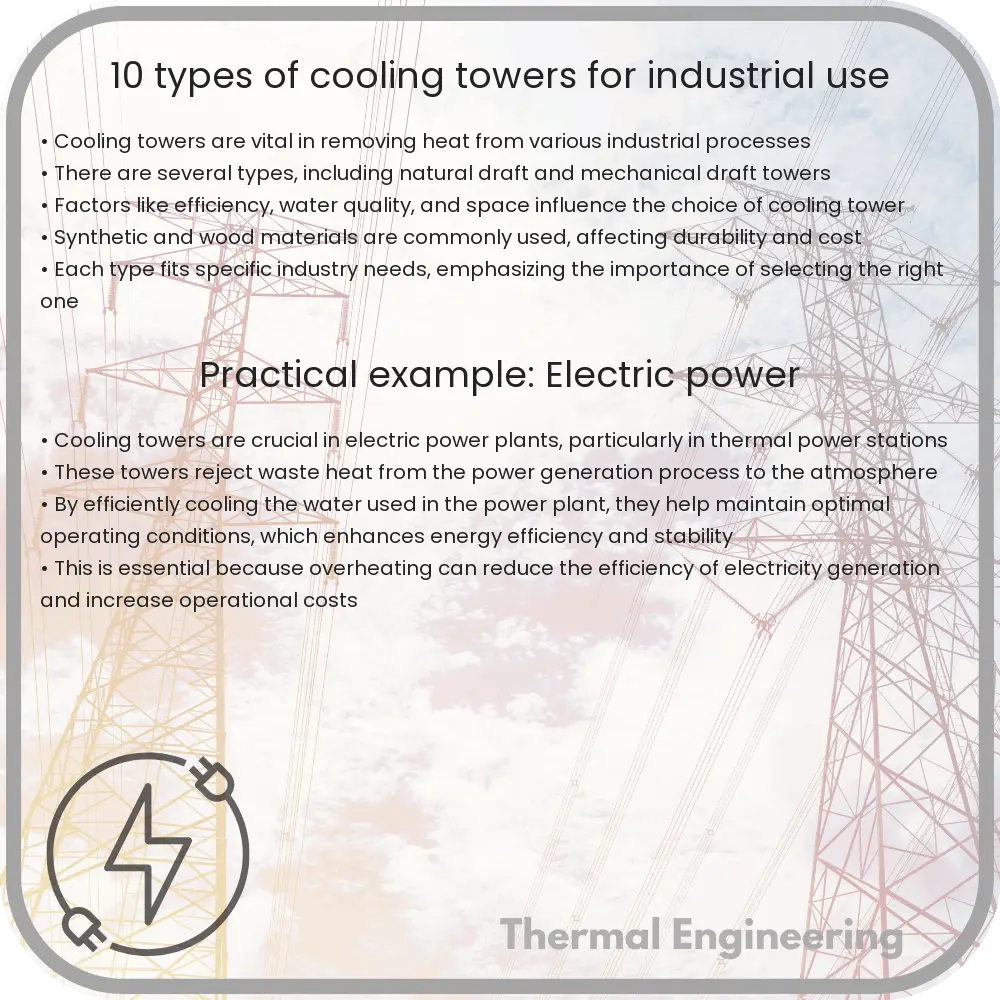Learn about the functions, types, and selection criteria of cooling towers in industrial settings.

Introduction to Cooling Towers
Cooling towers are a critical component in many industrial processes where heat needs to be dissipated to keep systems operational. These structures are used to remove excess heat from a cooling system by lowering the temperature of the water processed in the plant. This is typically achieved through the evaporation of water to remove process heat and cool the working fluid to near the wet-bulb air temperature. Cooling towers can vary widely in size, design, and functionality depending on the needs of the process and the climatic conditions.
Types of Cooling Towers
There are several types of cooling towers used in industrial settings, each with unique features and specific applications. Here’s a roundup of 10 common types:
- Natural Draft Cooling Towers
Utilize the natural upward flow of air to cool the water. They are typically very large, often used in power plants and other facilities with high cooling demands. Their operation is largely dependent on the ambient weather conditions.
- Mechanical Draft Cooling Towers
These towers use fans to force or draw air through circulated water. They are divided into further categories:
- Forced Draft: Air is forced through the tower by fans located at the air inlet.
- Induced Draft: Air is drawn through the cooling tower by fans located at the discharge (exiting airflow).
- Crossflow Cooling Towers
In these towers, the air flows horizontally through the falling water. This design allows for easy maintenance and reduced water clogging.
- Counterflow Cooling Towers
Air flows vertically upward, counter to the flow of falling water within the tower. This design typically provides better heat removal efficiency than crossflow towers.
- Hyperbolic Cooling Towers
These towers feature a distinctive hyperbolic structure that facilitates the natural flow of air, enhancing cooling efficiency through efficient circulation patterns. They are often used in large power plants.
- Field Erected Cooling Towers
Designed and constructed on the site, these are typically large structures that cater to industrial plants needing high-capacity cooling. They can be built in both crossflow and counterflow configurations.
- Package Cooling Towers
Preassembled and relatively smaller than field erected types, these are used in smaller applications like light industrial and commercial processes. They are easy to install and maintain.
- Plume Abated Cooling Towers
Designed to minimize the visible steam plume typically associated with conventional cooling towers. They are used in environments where the plume needs to be controlled to reduce visual impact or to comply with regulatory standards.
- Fluid Coolers or Closed Circuit Cooling Towers
These operate with a closed-loop system, meaning the process fluid is cooled without direct contact with the air or water. These towers avoid contamination and are generally used when the circulated fluid cannot be exposed to the open air.
- Evaporative Condensers
Designed to condense a refrigerant gas and cool it using water and a fan system. These are especially useful in refrigeration and HVAC systems.
Choosing the Right Cooling Tower
The choice of a cooling tower depends on several factors including the cooling load requirements, environmental conditions, water quality, space availability, and energy consumption. Additionally, each type of cooling tower has its own set of maintenance needs, cost implications, and operational efficiencies. Understanding the specific requirements of your industrial process can greatly aid in selecting the most appropriate cooling tower type.
Conclusion
Cooling towers are essential for managing heat in industrial environments. From massive hyperbolic towers to compact packaged models, the range of cooling tower types available today can meet virtually any industrial cooling need. Selecting the right type not only ensures efficient cooling but also optimizes operational costs and sustainability efforts.